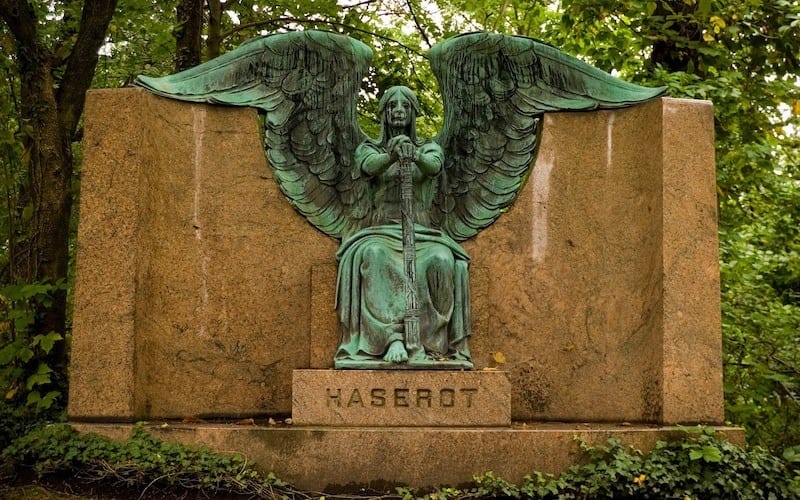Trending Now
Some people – okay, maybe most people – don’t seem to have much of a sense of humor when it comes to the topic of their own death and what may or may not come afterward. Which is totally fair, considering the seriousness of the topic. If, however, you can manage to look past the, you know, finality of the whole thing, it turns out there is room for some pretty awesome…let’s call them statements.
#20. The Tomb of Enrique Torres Belón (Lampa, Peru)

Photo Credit: Atlas Obscura
The mausoleum of Enrique Torres Belón, a tower of bones topped by a shiny replica of Michelangelo’s ‘Pieta,’ is undeniably creepy. There’s no doubt it stands out among the small, provincial charms of Lampa, a Peruvian town that still possesses a ton of 16th century charm.
The tomb, which holds both Belón and his wife, is lined with human skeletons and skulls exhumed from the town’s cemetery. At its base is a black marble cross that casts eerie shadows cast by the strange wall hangings. The strange result is that all of Lampa’s founding citizens seems to be gazing down on the couple for all eternity.
#19. Joseph Palmer (Leominster, Massachusetts)

Photo Credit: Atlas Obscura
Apparently, there was a time when a man wearing a beard was a point of contention – so much so, in fact, that when Joseph Palmer continued to wear one into the 1820s, long after they went out of fashion, he was criticized for being slovenly, ungodly, and even communing with the devil. Things got out of hand when Palmer was attacked outside of a hotel in Fitchburg, Massachusetts in 1830, a fight that ended with two men stabbed and Palmer in jail on assault charges.
He spent 15 months in jail, maintaining both his innocence and his facial hair the entire time.
When he died in 1865, he made sure that the likeness displayed on this tombstone wore – of course – a beard, making him the winner for all eternity.
#18. The Grave of Tom Thumb (Tattershall, England)
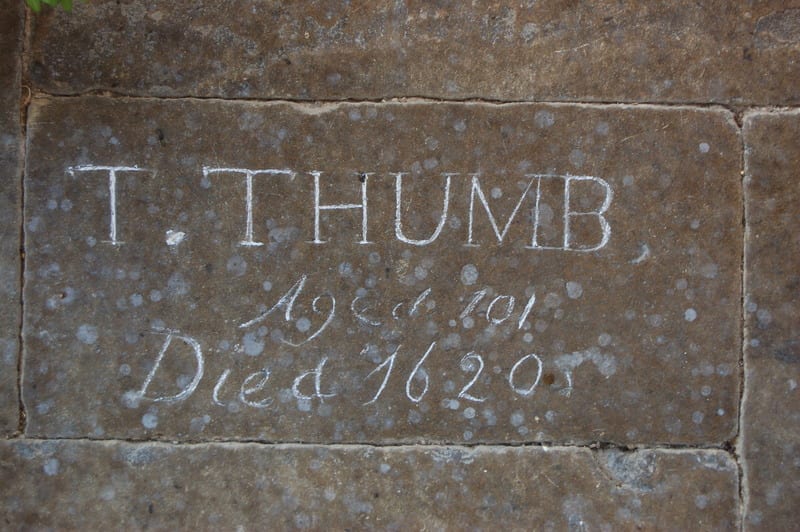
Photo Credit: Wikipedia
Tom Thumb stood, according to legend, just about 18 inches high and lived to the age of 101. When he passed away in 1620, the people of Tatterhsall, a village in the quaint Lincolnshire countryside, buried him inside the town’s church.
Or so they say. Traditionally, Tom Thumb is considered a fictional character – a cunning boy who used his size to trick people, much like the leprachaun legends of Ireland – and the person buried in Tattershall supposedly was a favorite of the King’s Court. Regardless of its truth, it is quite a charming English tale.
#17. Merchant Ball (Marion, Ohio)
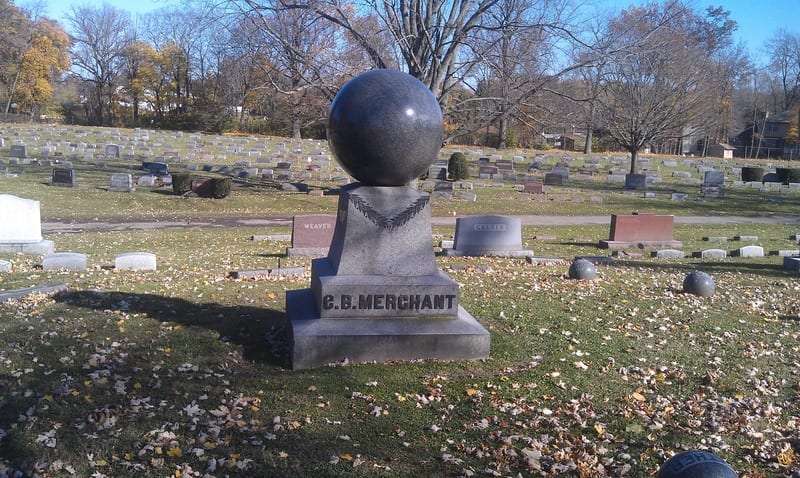
Photo Credit: Atlas Obscura
This is a strange one, and it begins with the Merchant family, prominent industrialists in Ohio who chose a huge sphere to go atop the grave of Charles Merchant in 1896. The ball was polished until it shone, and for a time, stood proudly still – until the day it began to mysteriously rotate on its pedestal.
The ball, which weighs 5,200 pounds, had not been properly secured because it was thought that the weight of it would hold it in place. Even though the Merchant descendants have tried securing the sphere with tar and other implements, it continues to rotate slowly for a reason no one can determine.
#16. John Paul Jones (Annapolis, Maryland)
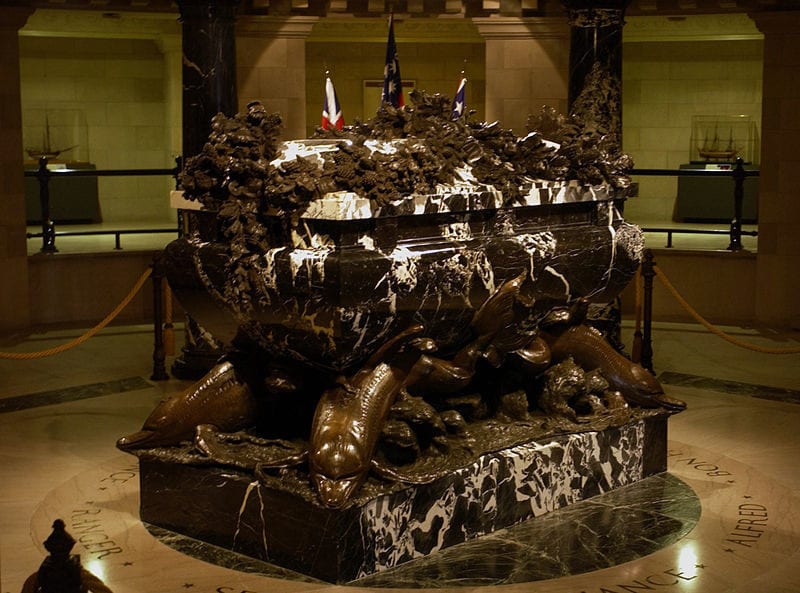
Photo Credit: Wikipedia
The father of the American Navy is commonly remembered for his statement, “I have not yet begun to fight” during the Revolutionary War. After America won her independence from Britain, Jones went to work for a time in the Russian Imperial Navy before retiring in France and, somehow, ending up in a cemetery belonging to the French royal family.
His remains were forgotten for a time before being discovered by an American ambassador in 1905 and returned to the States, where they’re now on display below the chapel of the United States Naval Academy. The impressive sarcophagus is sculpted out of black and white marble that makes it look as though it has been weathered by deep waters, and covered in barnacles. Bronzed dolphins bear it up from the base.
Talk about a statement.
#15. Nicolas Cage (New Orleans, Louisiana)

Photo Credit: Flickr
The 19th century gave us no lack of tombs in the shape of pyramids, but this one is different: it was built in the modern era…and it’s empty.
Nicolas Cage purchased a plot in the famous St. Louis Cemetery No. 1 in New Orleans (also home to the famous voodoo queen Marie Laveau), and promptly decorated his space with a stark, nine-foot stone pyramid. The actor hasn’t spoken about his reason for erecting the tomb, and speculation runs the gamut from his association with the Illuminati to an homage to his part in the National Treasure films.
Whatever the truth, many New Orleans locals aren’t happy about the actor’s ability to get space in the already cramped, historic cemetery.
#14. Jesus in Cowboy Boots (Paris, Texas)

Photo Credit: LOC.gov
Before a successful furniture and casket maker named Willet Babcock died in 1881, he asked master-stonecutter Gustave Klein to create an impressive memorial for his grave – there’s the typical carved wreaths, a cross, and an angelic figure in robes…that is sporting cowboy boots.
There has been some debate as to whether the figure is Jesus at all (some think it’s too effeminate, and sans beard), but either way, the good people of Paris, Texas refer to the monstrosity as “Jesus in Cowboy Boots.”
Because Texas, presumably.
#13. Afterglow Vista (Friday Harbor, Washington)

Photo Credit: Atlas Obscura
The memorial, officially known as the McMillin Mausoleum, was named for Freemason John S. McMillin. It’s not, in fact, a mausoleum at all but an open air rotunda that features a huge, limestone table at its center, complete with a set of chairs – meant to represent the family’s dinner table at home.
The chairs each contain the ashes of family members, with one left empty for the son who turned away from God.
#12. Mrs. Chippy Monument (Wellington, New Zealand)
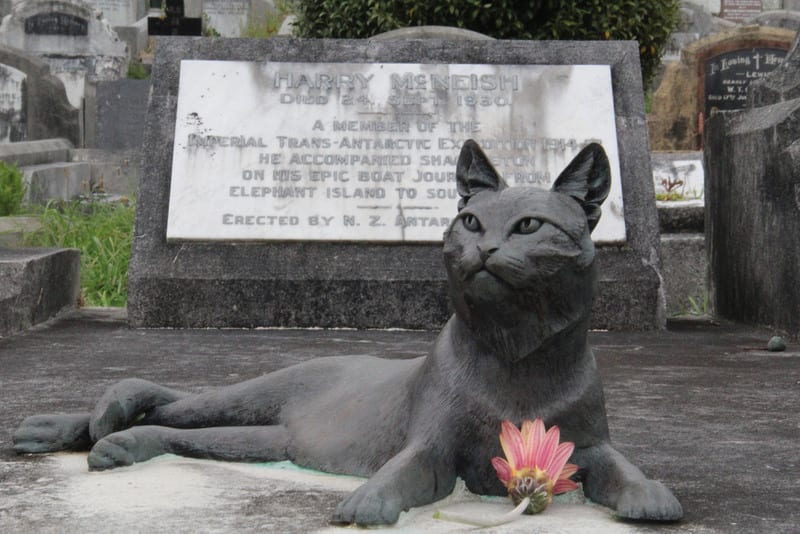
Photo Credit: Atlas Obscura
Ernest Shackleton’s Endurance Expedition to Antarctica was as long and miserable as every other polar exploration, save for one thing – Mrs. Chippy, the ship’s cat. Once the ship and the team became stuck in the ice, both Mrs. Chippy and the sled dogs were shot for food.
To honor the brave kitty, the New Zealand Antarctic Society added a bronze likeness to her caretaker’s grave in 2004.
#11. Colonel Buck (Bucksport, Maine)

Photo Credit: Delco Ghosts
Colonel Jonathan Buck, the founder of Bucksport, Maine, executed a witch in the early days of the town. She cursed him (obviously) and swore he would always bear the mark of his dastardly deed – and the legend tells that her leg fell from her body as it was being burned, and the stain on his grave is there as a reminder.
It looks like a macabre stocking on a fireplace, so I suppose in this scenario, it’s the witch who got the last word.
#10. William G. Bruce (Mt. Vernon, New Hampshire)
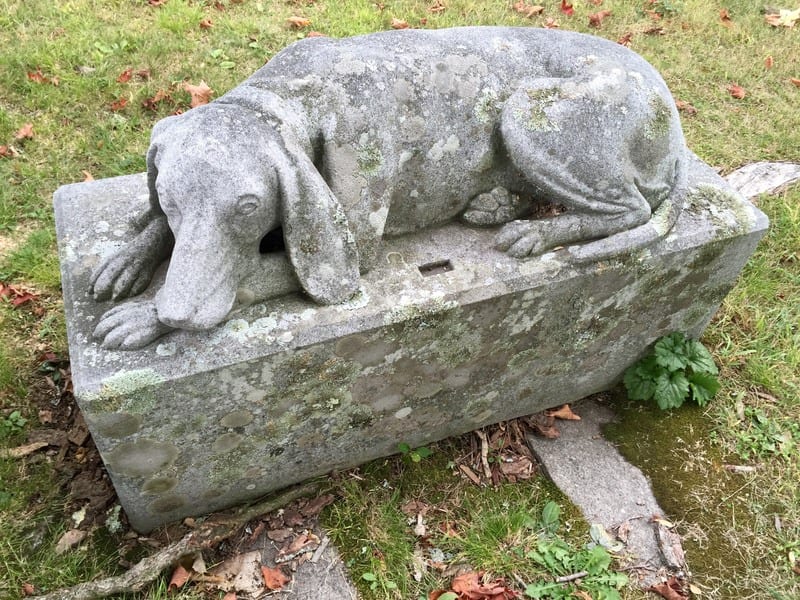
Photo Credit: Atlas Obscura
Who can resist man’s best friend? No one is the answer, and after William G. Bruce died in a hunting accident, his wife Augusta spent a pretty penny to commission noted headstone carver Peter Brennan. He crafted headstones for both her and her husband, with a granite dog who watches over them in the afterlife.
#9. Victor Noir (Paris, France)

Photo Credit: Atlas Obscura
Victor Noir led quite the 19th-century political life. The journalist ended his time on earth in the same sort of style – shot dead in a duel with Prince Pierre Bonaparte in 1870. He quickly became a symbol of imperial injustice and a martyr for the Republic, with thousands attending his funeral.
He’s depicted elegantly in death, his top hat tipped over his side. You might notice that two spots – his lips and his nethers, are rubbed shiny and bronze while the rest has succombed to years of oxidation.
That’s because his grave remains one of the most popular at Pére Lachaise Cemetery to this day, and generations of women have come to believe that kissing his lips and rubbing his, um, bulge, will bring them good luck.
#8. Steven Allan Ford (West Valley City, Utah)
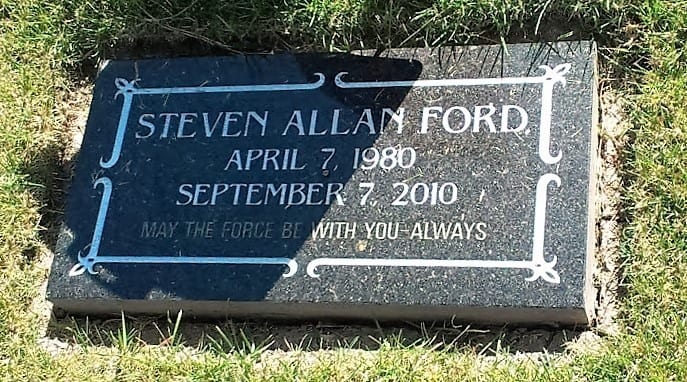
Photo Credit: Atlas Obscura
This headstone, which reads “Steven Allan Ford, April 7, 1980-September 7, 2010, MAY THE FORCE BE WITH YOU – ALWAYS,” belongs not to an overzealous fan, but to the first ordained Jedi priest in the Mormon-heavy state of Utah.
Seriously.
#7. Charles M. Higgins (Brooklyn, New York)

Photo Credit: Atlas Obscura
Charles M. Higgins was a history buff who believed the Battle of Long Island – the first Revolutionary War battle fought after the Declaration of Independence – didn’t get enough attention. So, he built a monument topped with a statue of Minerva, the Roman goddess of wisdom.
Now she stands, one arm outstretched toward the Statue of Liberty’s raised torch exactly 3.5 miles away. Their friendship, and the connection between past and present, has remained intact as their line of sight to each other remains unobstructed to this day.
#6. Lycian Rock Tombs (Fethiye, Turkey)
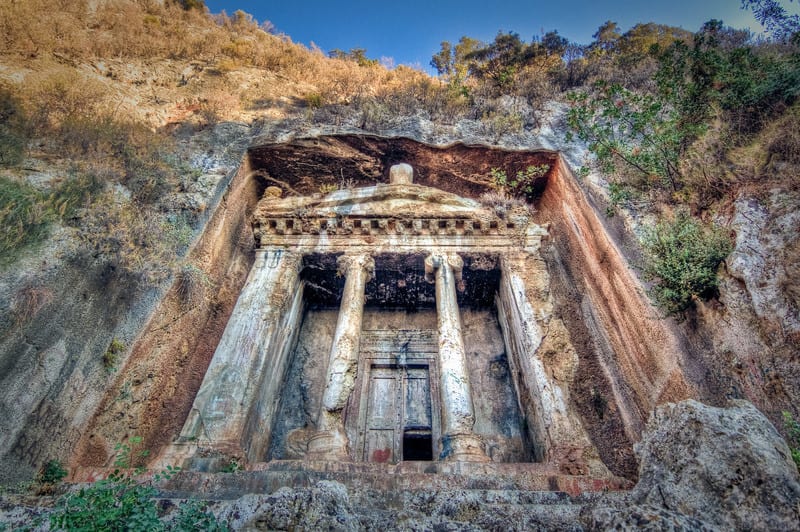
Photo Credit: Atlas Obscura
The ancient Lycians buried their dead in geographically high places, like cliffsides, to facilitate their ascent into the afterlife. Despite the ornate, carved columns protecting the entrances to the tombs, some of which date back to the 4th century, the interiors are spare chambers featuring a simple monolith. They did hold other treasures, once, before hundreds of years of looting left them bare.
#5. Davis Memorial (Hiawatha, Kansas)
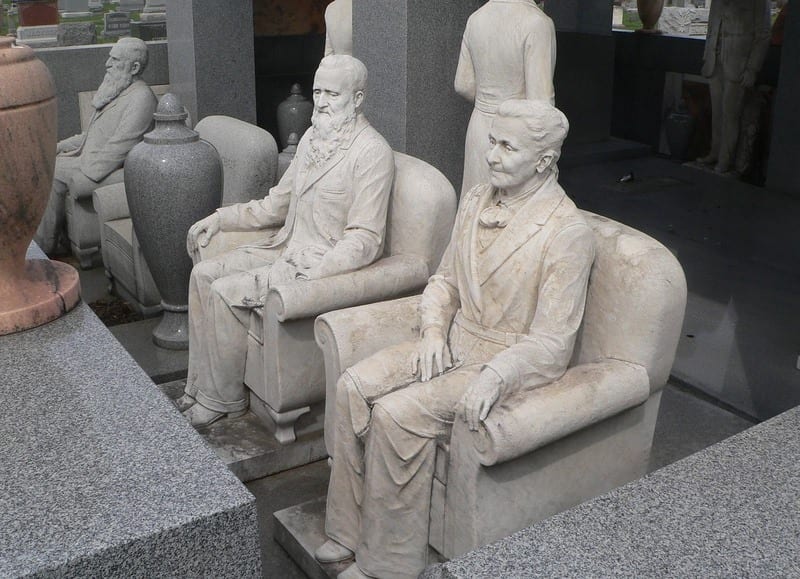
Photo Credit: Wikimedia
Was John Davis, the patriarch of a highly successful Kansas farming family, hateful and greedy, or merely a tad strange and permanently broken-hearted?
That’s the question people in Hiawatha tried to answer during the Great Depression, as they watched one of their most prominent citizens build expensive statue after expensive statue to honor his late wife while they lived without even a hospital to cater to their many needs.
Sarah Davis passed away in 1930, her grave originally marked with a simple stone that reflected the way the family had lived their lives until then. But it wasn’t long afterward that her husband replaced it with a marble statue – then another and another, until there were 11 increasingly haphazard and bizarre tributes to Sarah dotting the cemetery.
Those who don’t believe the gestures were done out of a desperate desire to feel close to his late wife speculate that John was attempting to spend all of their money in an attempt to keep it from Sarah’s family, who had never approved of him.
#4. Circus Train Wreck Victim’s Memorial (Columbus, Georgia)
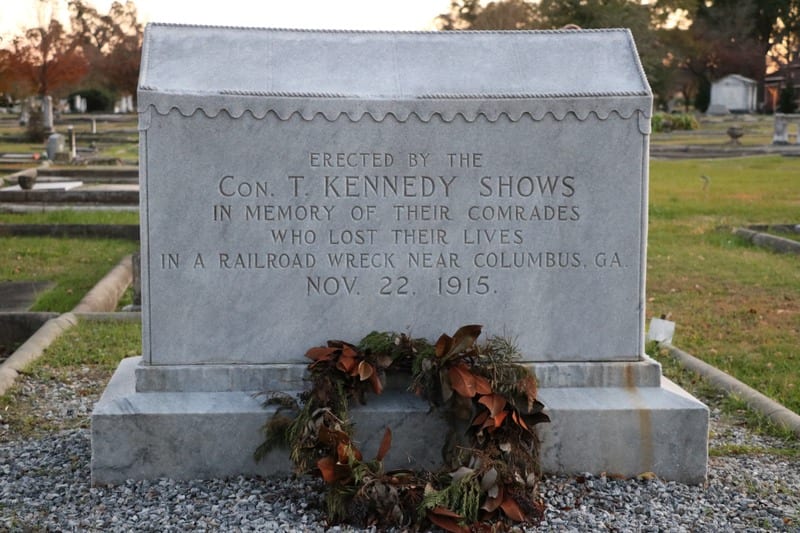
Photo Credit: Atlas Obscura
On the morning of November 22, 1915, the Kennedy Carnival Show train collided with a steel passenger train in Georgia. The powerful crash fused the engines together, and while the passengers on the sturdier steel train were able to escape alive and mostly uninjured, the Kennedy performers were not so lucky.
Pinned in their bunks, the cars on fire, at least 50 performers were injured or killed. The final number was never known, due to the transient nature of “show people,” but a mass funeral was held at the First Baptist Church in Columbus, Georgia before the bodies were interred at Riverdale Cemetery.
Con T. Kennedy chose a monument appropriate for the circus folk before heading back out on the road. The show must go on, after all.
#3. Jules Verne (Amiens, France)

Photo Credit: Atlas Obscura
If anyone deserves an awesomely creepy grave, it’s the father of science fiction. The sculpture atop his grave marker utilizes a real death mask of Verne himself, and depicts Verne breaking his own headstone as he crawls from his grave.
The iconic tomb has been featured in several issues of the science fiction magazine Amazing Stories, including the first issue in 1926.
#2. Ämari Pilots’ Cemetery (Ämari, Estonia)

Photo Credit: Wikimedia
In this air base graveyard, Soviet airmen are buried beneath the fins of the very aircraft many of them died inside – the graves are topped with actual parts from Russian aircraft. The memorials are dedicated to pilots who flew and died when Estonia was still part of the Eastern Bloc, making the site not only a haunting memorial to the men who died, but for Estonia’s past, as well.
#1. The Snow Tomb of Captain Robert Falcon Scott
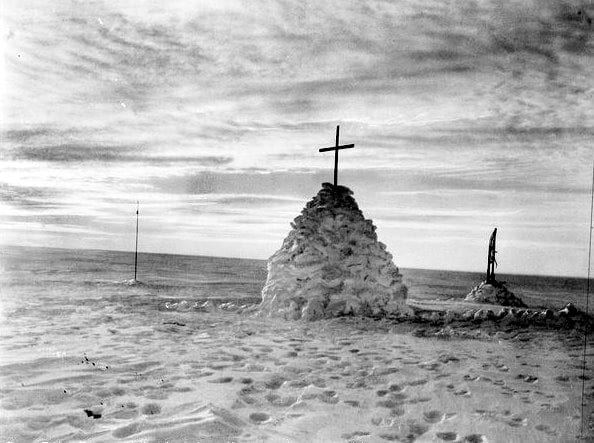
Photo Credit: Wikimedia
In 1911, Captain Robert Falcon Scott, the leader of the Terra Nova Expedition, vanished into the snow as he set off in search of the South Pole. Scott never returned, and a year later the rest of his crew went searching for him and found a “small object projecting above the surface of the snow.”
It turned out to be part of a tent, and inside it they discovered the remains of Scott and two of his men, Henry Bowers and Edward Wilson. Scott’s final diary entry ended with the words, “It seems a pity, but I do not think I can write more. For God’s sake look after our people.”
Their bodies were not returned to England, the crew instead deciding to honor them with a mound in the snow, topped by a stark cross, all of which was quickly buried in snow and ice. There is a permanent monument to the men on Observation Hill near McMurdo Station.
Want More? Check out the following articles:
12 Facts That Will Make You Smarter Than Your Friends
6 of the Creepiest Unsolved Mysteries of All Time
8 Really Weird Facts That Completely Change Everything
13 Facts About Dogs That You Probably Don’t Know
10 Survival Myths That Could Kill You
h/t: Atlas Obscura

